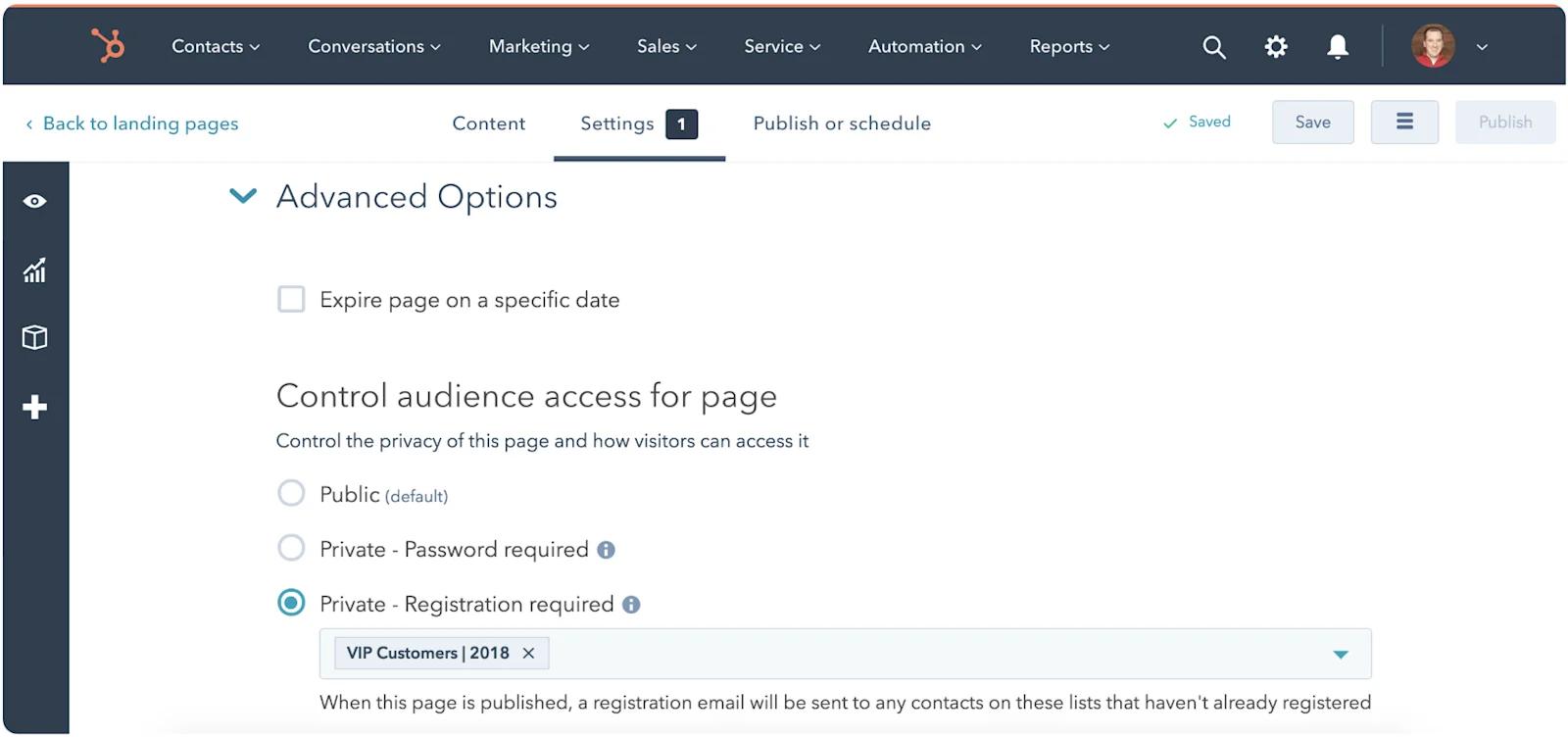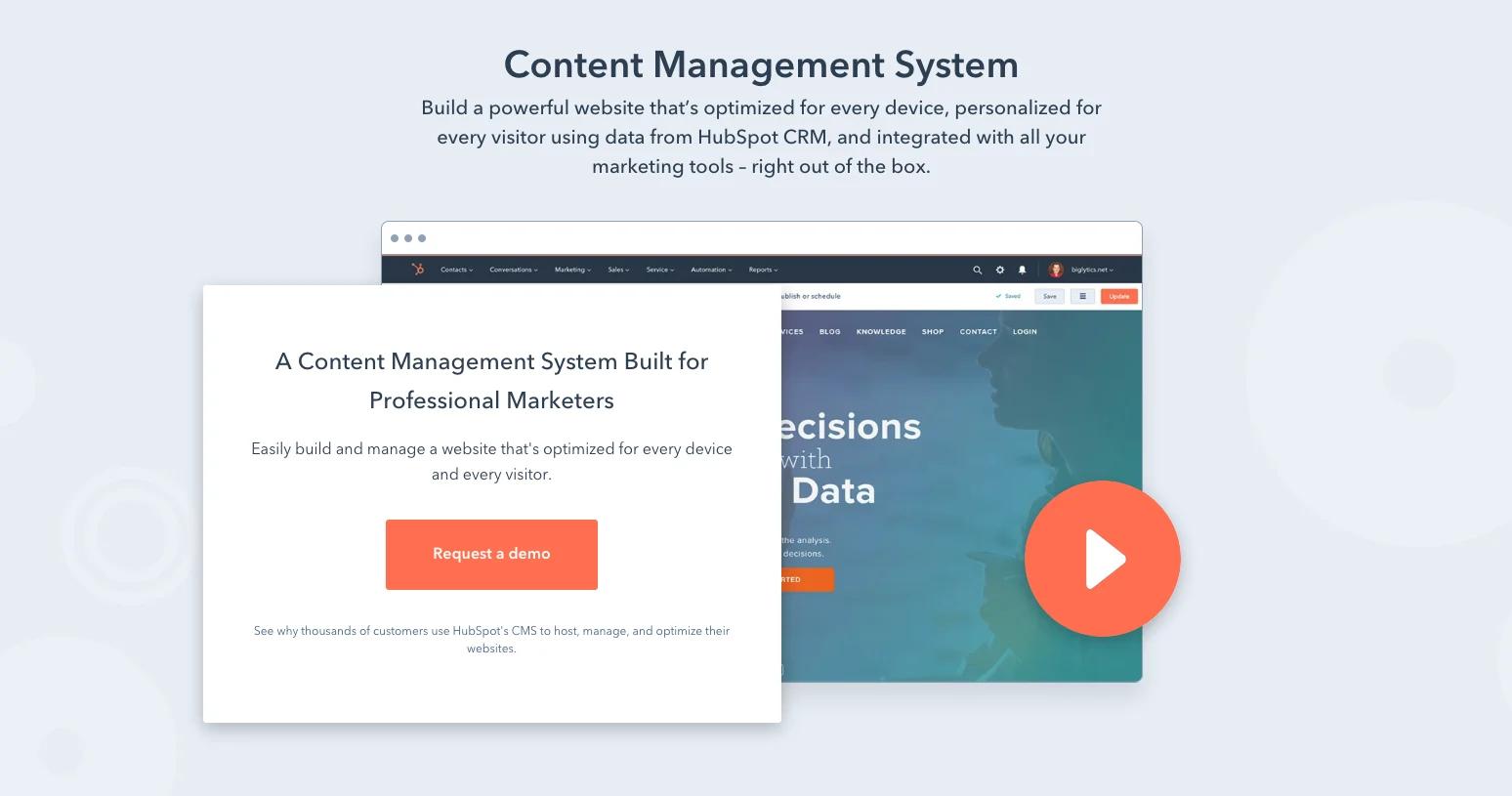HubSpot has evolved into an inbound marketing giant! They pledged to improve their CMS Hub and they did that. Let's check out the beef that makes up their advanced system built for developers and marketers to coexist.
What is a HubSpot Membership Site?
A HubSpot membership site offers exclusive content and features to registered members. Think of it as a gated community where only members access premium content, special offers, and personalized experiences. This isn’t just about locking content behind a login screen; it’s about creating a tailored, engaging experience for your most valuable users.
Examples of HubSpot Membership Sites
- Content Libraries: Offer exclusive eBooks, whitepapers, and webinars to members.
- Learning Platforms: Provide courses and certifications for your users.
- Community Forums: Create a space for members to interact and share insights.
- Customer Portals: Give your customers access to personalized dashboards and support.
Website Building Tools for Web Developers
Developers can come up with modules and layouts that make it easy for marketing teams to create and publish content using all of HubSpot’s tools. Simply put: Developers create the map and content creators fill it in.
How Web Developers Make it Painless for Content Creators
HubSpot suggests that solid, advanced websites are built beautifully when developers and content creators work hand-in-hand, understanding the needs of the creator who is filling up this map.
Because the CMS Hub bridges the gap between both parties, developers are enabled to work on more groundwork and layouts for other team needs.
Build HubSpot Themes and Modules for Scale
There is a HubSpot community of developers that share their templates, themes, and other useful resources, setting up a solid beginner’s groundwork for developers who are using the system for the first time.
If your team is not familiar with web development basics such as HTML, JavaScript, or CSS, it may take time to learn how to start building awesome websites. But with the help of HubSpot, they can show you the ropes with their descriptive, step-by-step tutorials.
A Marketer’s Playground for Creation
Creators finally have freedom
Content creators can fill in the fields and modules as they please once the template is built by the developer. Within the template, creators have access to different fonts, headings, bullet lists—you name it.
The drag-and-drop editor allows marketers (or anyone on your team) to create pages and update them at their discretion with no help from the swamped developers.
Optimize Your SEO Strategy
CMS Hub assists users with SEO recommendations to ensure they are maximizing their organic traffic. The SEO home tells creators how they can improve the next blog post, social media post, and social channel campaign.
With HubSpot’s reporting tools, a user can see where leads are coming from, what the engagement rate is, and how many times someone visited a specific page. Plan your next campaigns around the reports to drive more organic traffic to your site.
Which HubSpot Tier Suits your Team Better?
HubSpot offers two versions of their CMS Hub—one is more than just plain jane, but the other is a cheat code.
CMS Hub Professional
The CMS Hub is an all-in-one system aiming to create a memorable customer experience. With CMS Hub Professional, teams can monitor website engagement with HubSpot’s free CRM tool made for small to enterprise businesses.
Once the CMS Hub and CRM are connected, manage your contacts, email lists, and email schedules using email automation. Marketers can personalize content for different first-time website visitors—game changer!

hubspot-chatbot-screenshot
Are live chatbots essential to a website? HubSpot certainly believes they are! Setup the live bots to answer FAQs that your website visitors have and test different chatbot alternatives with HubSpot’s A/B testing.
Users can test two versions of a chatbox on every page of their site to measure which performs better with the target audience. Using A/B testing will help you optimize and scale your whole website, increasing ROI!
Hub Professional has more to offer, but here are some features that are worth mentioning:
- Dynamic content with HubDB → Construct tables filled with content, update the content whenever and those changes will reflect throughout the site wherever the table exists.
- Salesforce integration → Integrate 1 Salesforce account to HubSpot and utilize the 1,000 field maps available.
- Design manager → This will be the home for the development team—with HTML, Javascript, and CSS, developers can build pages for their fellow content creators.
- Content analytics views → Receive a report for each of your pages, showing you the number of views, number of visitors, and the time spent per page.
CMS Hub Enterprise
Hub Enterprise consists of all the Hub Professional features and more! Users can expect serverless functions, brand domains, and activity logs for CTAs to build dynamic marketing experiences for end-users—but to build great experiences, teams must stay woke.
With the code alerts, developers know when CX is being affected by slow site speeds or design problems that need to be attended to immediately. No more aimless conclusions about what could be causing the bug in the site. Teams can now locate the bug and squash it!

hubspot-CMS-Membership
Businesses can also create content that is only for customers who hold memberships, giving them the ability to manage premium content channels on their site. Build exclusive content for paying customers to open up a new revenue opportunity.
In regards to size, Hub Enterprise is built for hierarchical teams so segmenting work can seem like a pain. However, the partitioning feature segments the work so that specific team members can only be allowed to access the content that they are working on.
There is much more on Hub Enterprise, but for now, here are a few other features that can keep your growth-driven enterprise on track:
- Custom CDN configuration → Gives your team the ability to track how visitors are accessing your website for security reasons.
- Adaptive testing → Test up to 5 pages at a time to discover which page will perform the best according to your optimization strategy.
- Site performance monitoring → Have full insight on which areas of their website are performing and which areas are underperforming.
More with HubSpot's CMS Suite
HubSpot’s CMS Hub is designed to work with the rest of their hub (marketing, sales, and service hub) to improve both the development and marketing team’s experience with website building.

hubspot-cms-hub-suite
Having the whole pie makes it a more appealing choice to scale all of your inbound marketing with every HubSpot tool within reach.
Types of Membership Sites You Can Create with HubSpot
HubSpot membership sites can help you achieve user engagement, customer retention, and streamlined operations.
Content-Based Membership Sites
- Exclusive Content Access: Offer members-only articles, videos, and resources.
- Benefits: Keeps users engaged and encourages them to return for more.
- Setup: Use HubSpot’s CMS to create gated content pages.
Service-Based Membership Sites
- Premium Services: Offer consulting, coaching, or specialized support to members.
- Features: Schedule appointments, track service usage, and manage renewals.
- Management: Integrate with HubSpot’s CRM to keep track of member interactions.
Product-Based Membership Sites
- Physical or Digital Products: Offer early access or exclusive products to members.
- Integration: Seamlessly connect with e-commerce platforms for smooth transactions.
- Examples: Subscription boxes, digital downloads, and exclusive merchandise.
Benefits of Using HubSpot for Membership Sites
Enhanced User Engagement
- Personalized Content Delivery: Use HubSpot’s CRM to tailor content to each member.
- Marketing Automation: Send automated emails and notifications to keep members engaged.
Streamlined Membership Management
- Automation of Repetitive Tasks: Automate sign-ups, renewals, and reminders.
- Simplified User Management: Easily manage member data and interactions through HubSpot’s dashboard.
Improved Customer Retention
- Loyalty Programs: Offer exclusive rewards and discounts to keep members coming back.
- Continuous Engagement: Use HubSpot’s tools to maintain regular communication with members.
Scalability and Performance
- Handling Growth Efficiently: HubSpot’s infrastructure can handle an increasing number of members without compromising performance.
- Performance Optimization: Use analytics to continually improve the user experience.
How to Set Up a Membership Site on HubSpot
Setting up a membership site might sound daunting, but let’s break it down into manageable steps.
Planning Your Membership Site
- Defining Goals and Objectives: Know what you want to achieve.
- Structuring Membership Tiers: Decide on different levels of membership and what each tier offers.
Setting Up Membership Pages
- Creating Sign-Up and Login Pages: Use HubSpot’s CMS to design user-friendly pages.
- Customizing Membership Dashboards: Tailor the dashboard to show relevant information to each member.
Integrating Payment Gateways
- Supported Payment Options: Use Stripe, PayPal, or other payment gateways supported by HubSpot.
- Setting Up Recurring Billing: Ensure members are billed automatically for renewals.
Managing Member Data
- Using HubSpot CRM for Member Information: Keep all member data organized and easily accessible.
- Data Privacy and Security Measures: Implement best practices for data protection.
Enhancing User Experience
- Personalization Strategies: Use HubSpot’s tools to deliver personalized content and experiences.
- Mobile Responsiveness: Ensure your membership site looks great and functions well on all devices.
Best Practices for Managing HubSpot Membership Sites
Content Creation and Management
Regularly updated content keeps members coming back. Stale content can lead to disengagement.
- Regular Content Updates: Schedule regular updates to keep your content fresh.
- Engaging Multimedia Content: Use videos, infographics, and interactive elements to make your content more engaging.
User Communication and Support
Communication is key to maintaining a strong relationship with your members.
- Automated Email Workflows: Set up automated emails for new content, upcoming renewals, and special offers.
- Live Chat and Support Channels: Provide real-time support to address member queries quickly.
Analyzing Membership Metrics
Understanding how your membership site performs helps you make data-driven decisions.
- Key Performance Indicators to Track: Monitor metrics like member retention rate, engagement levels, and revenue per member.
- Using HubSpot Analytics Tools: Leverage HubSpot’s built-in analytics to track and analyze these metrics.
Continuous Improvement and Updates
Your membership site should evolve based on user feedback and performance data.
- Gathering User Feedback: Regularly solicit feedback from your members to understand their needs and preferences.
- Iterative Improvements Based on Data: Use the data you gather to make continuous improvements to your site.
How to Integrate Third-Party Tools with HubSpot Membership Sites
CRM and Marketing Tools
Integration with other CRM and marketing tools can enhance your membership site’s capabilities.
- Integrating with Other CRMs: Sync member data with other CRM systems like Salesforce for a unified view of your customers.
- Email Marketing and Automation Tools: Use tools like Mailchimp or ActiveCampaign to enhance your email marketing efforts.
Payment and Subscription Management
Managing payments and subscriptions efficiently is crucial for a smooth user experience.
- Using Tools Like Stripe and PayPal: Integrate these payment gateways for secure and seamless transactions.
- Managing Subscriptions and Payments: Automate subscription renewals and payment reminders to reduce manual workload.
Analytics and Reporting
Advanced analytics tools can provide deeper insights into your membership site’s performance.
- Integration with Google Analytics: Track user behavior and site performance with Google Analytics.
- Using Advanced Reporting Tools: Tools like Databox or Looker can offer more sophisticated reporting capabilities.
Customer Support Systems
Providing excellent customer support is essential for member satisfaction.
- Integrating Helpdesk Software: Use tools like Zendesk or Freshdesk to manage support tickets and improve response times.
- Enhancing User Support Experience: Implement a knowledge base or FAQ section to help members find answers quickly.
Common Challenges and How to Overcome Them
Technical Complexity
Worried about the technical aspects? You’re not alone.
- Simplifying Setup with Templates and Tools: Use HubSpot’s pre-built templates and tools to simplify the setup process.
- Accessing HubSpot Support Resources: Take advantage of HubSpot’s extensive support resources, including tutorials and community forums.
Integration Issues
Ensuring compatibility with your existing systems can be tricky.
- Ensuring Compatibility with Existing Systems: Test integrations thoroughly to ensure they work seamlessly with your existing tech stack.
- Troubleshooting Common Integration Problems: Use HubSpot’s integration guides and support to resolve any issues.
Ensuring Data Security
Data security is a top concern, especially when handling sensitive member information.
- Best Practices for Data Protection: Implement robust security measures like encryption and two-factor authentication.
- Compliance with Data Privacy Regulations: Ensure your site complies with regulations like GDPR and CCPA.
Cost Management
Worried about the costs? Here’s how to manage them effectively.
- Budgeting for Membership Site Setup and Maintenance: Plan your budget carefully, considering both initial setup and ongoing maintenance costs.
- Calculating ROI and Cost-Effectiveness: Track your membership site’s performance to ensure it delivers a good return on investment.
Is a HubSpot Membership Site Worth It?
Assessing the Value for Your Business
Consider the specific needs and goals of your business.
- Benefits vs. Costs Analysis: Compare the potential benefits, like increased engagement and customer retention, against the costs of setup and maintenance.
- Long-Term Growth Potential: Think about how a membership site can support your long-term business goals.
Success Stories and Case Studies
Real-world examples can provide valuable insights.
- Examples of Businesses Benefiting from HubSpot Membership Sites: Look at case studies of businesses similar to yours that have successfully implemented HubSpot membership sites.
- Lessons Learned from Successful Implementations: Learn from their experiences to avoid common pitfalls and maximize your site’s potential.
Final Thoughts
A HubSpot membership site can be a powerful tool for enhancing user engagement, improving customer retention, and streamlining operations. Evaluate your specific needs and goals to determine if it’s the right fit for your business.
If you are considering migrating to HubSpot, don’t hesitate to contact us! The Webstacks team is here to help you answer any questions. Still not convinced? Check out our previous blog and see how HubSpot’s CMS Hub compares with other CMS platforms.




